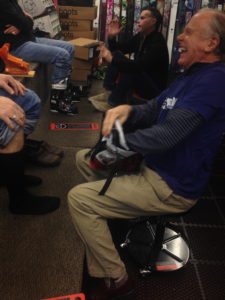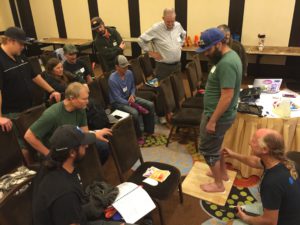An alarming number of skiers assume that ski boots hurt, period. Every boot they ever put on, beginning with rental boots, then their first pair of boots bought as part of an entry-level package and even the next pair of supposedly better boots, all hurt like hell. This “understanding” is what fuels the average boot buyer to be more circumspect about his or her next purchase, vowing to take charge of the sale and not putting up with less than ethereal comfort.
This is a terrible idea.
While I empathize with the plight of skiers fed up with incessant discomfort, an analysis of the root causes of their pain will reveal why customers ought not to trust their own judgment when it comes to buying boots. Let’s rewind this film and see where things went off the rails.
As in any good relationship, the one with your bootfitter is based on trust
and lubricated by a well-developed sense of humor.
Let’s begin at the beginning, with rental boots. They don’t have to be terrible, but they often are. To speed the rental process, the boots are all lasted for wide feet, then over-sized for good measure. This makes it almost impossible to learn how to ski, which helps account for skiing’s staggering inability to maintain first-timers, and the overall experience leaves the skier hopelessly confused about how a ski boot is supposed to fit.
The package boot sold with a ski and binding isn’t much of an improvement. It will fall into the genre I refer to as “Buckets of Love.” The customer raises no objections at the time of sale as the boot barely brushes against the foot inside it. Once set in motion, the foot is so unstable it’s like standing in two basins filled with lard. The best skiers in the world couldn’t even fall out of the starting gate in mukluks like these, so what chance does our hapless first-time buyer have?
Fortunately, not all people are so easily discouraged and attempt to buy another, better pair of boots. Unfortunately, the definition of “better” is a little fuzzy. The only criterion the customer insists on is the damn things shouldn’t hurt. So the helpful salesperson selects boots that are a little wide and a little long, just for good measure. Customer agrees that they are as comfortable as slippers.
This happy moment doesn’t last, and in fact proves almost impossible to replicate on hill. Instead of getting him off the road to perdition, the new boots seem to steer our beleaguered fellow skier back onto the express lane to hell.
How can this poor soul be saved?
To get back on the path to paradise, this boot buyer needs to avoid 3 classic pitfalls that doomed his earlier efforts, by adhering to these guidelines:
- The boot buyer who has yet to experience a decent fit is ill equipped to be in charge of a process about which he knows little or nothing. Most people’s knowledge of boots could fit in a thimble and have plenty of room left for what they know about feet. A veteran bootfitter will know exactly what boots should fit and ought to be able to explain the steps required to achieve success. Surrender to his care.
- The boot you’re convinced is too short isn’t. The primary cause of all the myriad miseries endured to this point is over-sizing. All new boots have an inherent fit tension that needs a minute or two to relax. Have a little trust and demonstrate a modicum of patience. Getting a boot fit right takes time and a spirit of collaboration.
- Improve the underfoot support. A stable, comfortable fit requires a stable, firmly held foot, which begins with a better insole that cradles the heel and matches the shape of the arch. Stock insoles are made to be inoffensive rather than supportive and serve primarily as space fillers. A custom insole, in conjunction with accurate shell fitting and stance alignment, will do more to improve one’s skiing than a week of generic class lessons.
The alert reader will note that for this scenario to have a happy ending, the bootfitter involved has to have a working knowledge of foot and lower leg anatomy and an intimate understanding of the attributes of every boot in his shop’s inventory. Such individuals, sad to say, aren’t found on every street corner.
Board Certified Pedorthist Greg Hoffman leads an advanced
seminar on stance alignment at MasterFit University.
It takes some formal education and years of on-the-job training to create a great bootfitter. The on-the-job training usually comes from working at a specialty shop. The formal education, rigorously pursued, leads to Board Certification as a Pedorthist. Such savants are rare, but worth seeking out when all other avenues have led to dead-ends.
Since it’s axiomatic that a very limited number of people will pursue a degree in the medical field in order to work retail, there’s a shortage of Board Certified Pedorthists plying their trade at ski shops. Fortunately there’s a cadre of BCP’s dedicated to educating the masses under the banner of MasterFit University.
A hands-on workshop on boot modifications at
MasterFit University.
MasterFit University offers only a two-day program and it issues no degrees or certifications, but the teaching is as impassioned as it is informed and the hands-on workshops are invaluable. In the absence of any industry-wide skills certification, attendance at MasterFit classes at least indicates a commitment to doing a better job of serving the American skiing public.
If you’re a member of said skiing public, I encourage you to patronize shops that belong to the Realskiers test shop network, America’s Best Bootfitters or employ staff with multiple MFU seminars under its collective belt. It’s the best assurance you can get in an uncertain world that the person examining your feet has some idea what he’s doing.




